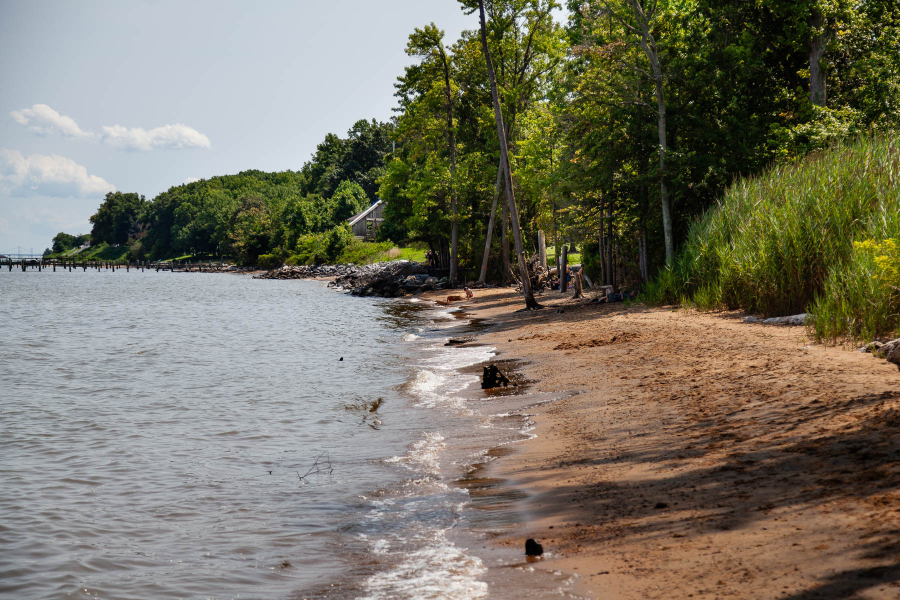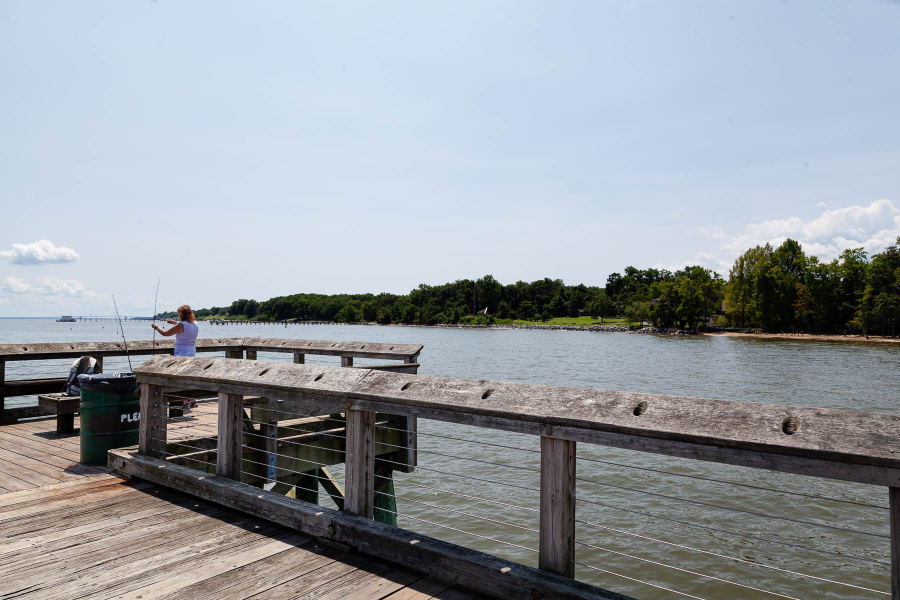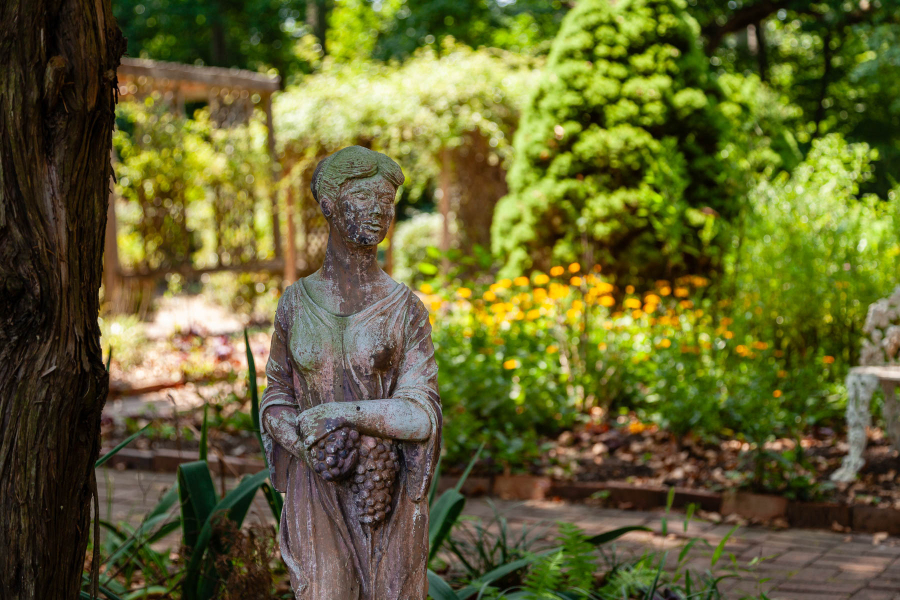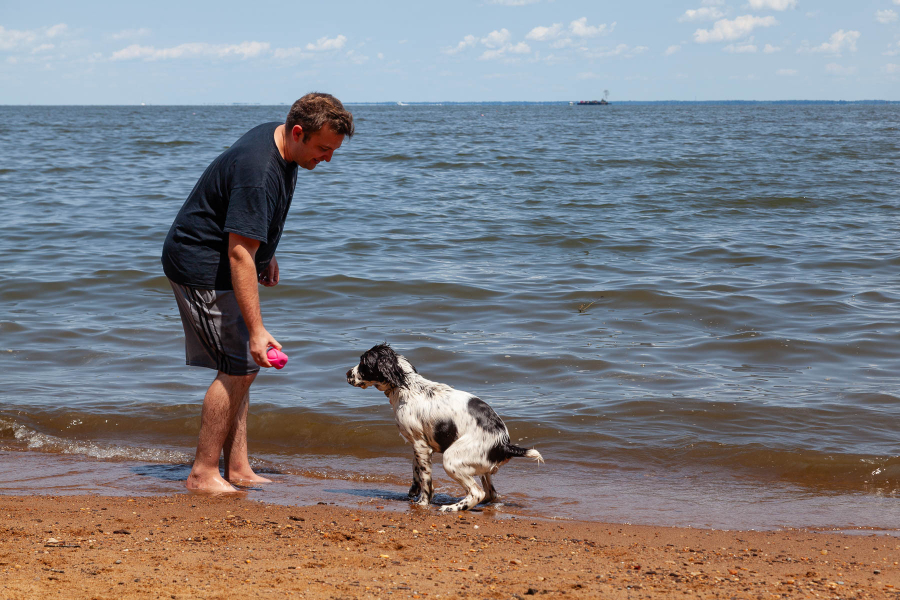A day well spent at Downs Park
Find the perfect balance between nature, history and recreation at Downs Park in Pasadena, Maryland

Approaching the entrance, I spotted a dark wooden sign standing behind flourishing lavender and shrubs that read “John (Jack) H. Downs Memorial Park.”
I continued forward until my car sat parallel to the wooden gatehouse. I presented my bright orange Anne Arundel County Recreation and Parks pass to the attendant and proceeded into the property. Within seconds, the fond memories of my favorite community park came back to me—nearly 15 years since my first visit.
My connection to Downs Park began in elementary school, when I went to summer camp every year with my older sister, Sami. I have fond memories of us playing capture the flag, tie-dying t-shirts and creating box-styled gimp keychains, though I could never start the weaving pattern myself.
Looking back, I remember the more educational lessons, too, like creating recycled paper from newspaper scraps and completing a scavenger hunt of the park’s native plants.
Whether I recognized it at the time or not, what I loved so much about Downs was the balance between nature and recreation. The two could not only coexist but would complement each other in the most beautiful ways.
History of Downs Park
This 236-acre park is situated on the Chesapeake Bay right between Baltimore and Annapolis, in the small town of Pasadena, Maryland. Due to its favorable location between two major cities and access to the Bay’s fish, crabs and oysters, this land has a long and unique history.
In 1982, one of Downs Park’s first rangers, Rick Holt, sought to unravel this history. To do just that, Holt hosted a “Local History Meeting” where he invited Pasadena residents to the park via an advertisement in the former Maryland Gazette.
With 18 people in attendance—many of which were former owners of the land—the meeting was very successful. Holt gathered oral history and artifacts that made way for the founding of the Downs Park Historical Society, a group dedicated to preserving pieces of the land’s history.

The first recorded owner of the land was Richard Caton of Baltimore. With a loan from his father-in-law, Charles Carol of Carrollton, the last living signer of the Declaration of Independence, Caton secured the land in the early 19th century.
Over the next 100 years, the land bounced around from different families who used it for a variety of purposes. While the land was primarily used for lumbering, produce like watermelon, tomatoes and cantaloupe were grown here and shipped north to markets in Baltimore.
In 1912, Hunt Reynolds Mayo-Thom of Baltimore bought the land as a summer estate for his family. They referred to the land as Rocky Beach Farm. The majority of the land’s documented history is from this time period, especially from Catherine Mayo-Thom, the family’s eldest daughter.
Mr. Mayo-Thom passed away from pneumonia in 1925, just four years before the start of the Great Depression. Heartbreaking to the family, this sequence of events forced Mrs. Mayo-Thom to put Rocky Beach Farm up for sale.
After six long years of being on the market, a successful Baltimore general practitioner by the name of Dr. George William Bishop Jr. bought the land in 1937. This land served as a summer estate for Dr. Bishop, his wife and their four children for the next 30 years until Dr. Bishop’s passing in the 1960s.
A couple families owned the land for short periods until Anne Arundel County eventually purchased the property in 1976.
Modern Downs Park
After I collected my things and locked my car, I headed to Mother’s Garden–an early 1900s Edwardian style garden. Built by Reginald Giddings, Rocky Beach Farm’s resident handyman, the garden became Helen Mayo-Thom’s pride and joy—hosting two of her daughters’ weddings.
How serene it was. I entered under a series of wooden gazebos with vines climbing the crosshatched trellises. Brick walkways separated small garden plots full of shrubs, trimmed hedges and a variety of flowers like Black-eyed Susans, zinnias and orange and purple coneflowers. Carefully placed among them were small, white, stone cherubs and goddesses.
I rested on a shaded bench near the perimeter of the garden and took it all in. I watched monarchs flutter amongst the flowers and was startled by the occasional splash of a northern cardinal dunking in the bird bath.

In the wooded portion of Mother’s Garden is the wishing bench–a moss-covered stone bench also built by Giddings for the Mayo-Thom family. As instructed, I took a seat, closed my eyes and made a wish.
After a bit of wandering in the wooded area, taking full advantage of the shade, I spotted a sign that read “aviary,” unlocking another memory from my childhood.
The aviary at Downs Park provides a home for birds of prey that cannot be rereleased back into the wild. With the assistance of park staff, volunteers and visitors, these birds receive excellent care and serve as an educational opportunity, highlighting the significance of respectfully coexisting with wildlife.
When I arrived at the tall, wired aviary, I was disappointed to find an “in loving memory” sign for Snappy, a feisty yet charming great horned owl who was my favorite to observe when I was younger. Camp counselors would shush us when approaching the enclosure to ensure that we wouldn’t disturb Snappy with loud and abrupt noises.
“The joy that she brought us through her living, however, will far outweigh the heartbreak we feel in her passing,” wrote full-time Downs Park Ranger Stacey Wolfe on her memorial.
Twirl, a black vulture, now occupies Snappy's former spot, while in the adjacent enclosure resides Buddy, a red-tailed hawk. I watched as both birds retreated to the rear of their enclosures in search of relief from the early afternoon heat.
![[LEFT] The edge of a pond is flourishing with bright green shrubs and grasses. [RIGHT] Many species of turtle that vary in size and shown surfacing from the greenish colored pond water](https://www.chesapeakebay.net/files/_900xAUTO_crop_center-center_100_none/aug_7_23_1800-03.jpg)
I exited the aviary through a narrow opening in the trees, expanding my sights to the South Overlook Pavilion—a shaded, wooden deck that provides the perfect view of the Bay. Ascending the steps from the lower walking path, I met Kenny and Ruth Lipman—two longtime Pasadena residents and park patrons.
“The osprey nest is my favorite part of the park,” said Kenny, motioning to the bundle of thin sticks perched atop a wooden post in the water.
“No,” Ruth disagreed. “The view of the Bay is the best part.”
The couple went back and forth sharing some of Down’s most favorable features until eventually finding some common ground on the park’s bee hotels. Both Kenny and Ruth assured me that this was a must-see.
Although currently inactive, the bee or pollinator hotels are designed to offer sanctuary and nesting sites for solitary bees. These man-made habitats consist of various cavities made up of hollowed reed and drilled wood. Thoughtfully placed in the meadows and gardens of Downs Park, where pollinators are especially needed, these hotels contribute to bee conservation which ultimately promotes successful plant growth.
With the sun reaching its peak, I headed towards the Brightwater Pavilion for lunch. At Downs, each pavilion is named after the original Rocky Beach Farm guest cottages that once stood in its place. With their extensive wealth, Mr. and Mrs. Mayo-Thom had built seven of these small homes to accommodate their in-laws, friends and handymen over the summer.
Of all the pavilions, Brightwater is the most accurate commemoration. The modern pavilion incorporates the cottage’s stone hearth and chimney—the sole surviving architectural elements of Rocky Beach Farm.
On the northern end of Downs lies the pond overlook. A wooden walkway accommodates the land’s sloped topography, navigating through aged oak and white ash trees. A platform sits at the end of the path, providing an aerial view of the partly sunlit water.
Prehistoric-looking snapping turtles crept eerily through clusters of hydrilla and other aquatic vegetation, while on the water’s surface, playful eastern painted turtles and red eared sliders splashed about, periodically bumping into each other and small fish.

Downs’ 2,000-foot shoreline is one of the park’s many attractions. A unique feature of this shoreline is a small dog beach at the north end of the park. The calm, shallow waters provide the perfect opportunity for dogs of all sizes to safely splash and swim in the Bay.
A 330-foot wooden pier sits just down the shoreline, excellent for fishing and boat watching. When approaching the pier, I observed half a dozen families dispersed along all 330 feet, marking their respective sections with umbrellas, coolers and fishing equipment.
When I was no older than seven years old, my Pop took my sister and I fishing on this very pier. While I didn’t catch anything, apart from my hook on the hook of another, I’ll always cherish the memories of that day.
Written records prove that fishing has always been a popular pastime at Downs Park. White perch, sunfish, rockfish, hardhead, blues, toadfish and eels were documented as common catches. According to Catherine Mayo-Thom, daughter of Hunt and Helen, the family spent many evenings fishing off the “summer house” gazebo which stood in the place of the modern south overlook.
Fishing is only one of many recreational activities welcomed in the park. In addition to the kayak launch, newly-renovated playground and assortment of basketball and volleyball courts, the park also includes an amphitheater that stages a collection of bands from late spring to early fall.
The people who make it happen
Behind this beautiful park is dedicated staff who work tirelessly to maintain the park and provide visitors with the best experience possible. The 16 person staff composed of full time and seasonal rangers, full time and seasonal maintenance workers, gate attendants, a maintenance supervisor, a receptionist, and an office manager are all overseen by the park superintendent.
“We are a tight knit unit—really a work family—that collaborate to care for the park and handle all aspects of customer service," explains Ranger Stacey Wolfe.
You can’t forget Friends of Downs Park, Garden Volunteers, Volunteers-in-the-Park and the Downs Park Quilters Guild—four groups devoted to gathering funds and volunteers to support the operation, management and preservation of this Pasadena gem.
As I turned left out of the park and headed home, I felt an overwhelming sense of appreciation. Downs Park holds so many cherished memories for countless families, including my own. Protecting Downs Park means preserving these memories and ensuring that many more families, for generations to come, can continue to take full advantage of all this park has to offer.

Comments
Who was john c (jack) downs?
Thank you!
Your comment has been received. Before it can be published, the comment will be reviewed by our team to ensure it adheres with our rules of engagement.
Back to recent stories